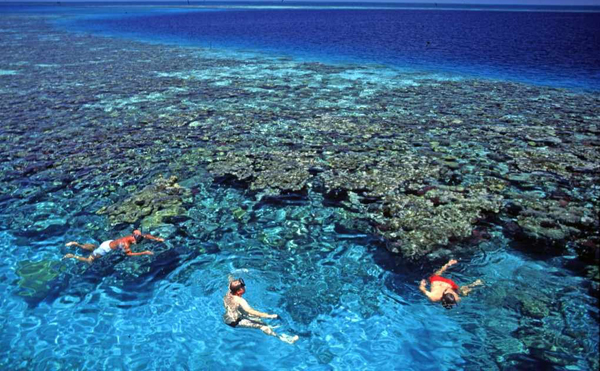

 |

|

|
|
Surrounded by one of the world's largest expanses of sand, the Red Sea laps the shores of an ecosystem seemingly devoid of life.
For that reason, many people find it difficult to imagine that some of the earth's richest coral reefs rise from the floor of the sea's northern reaches.
Marine scientist Eugenie Clark has no such difficulty: "If I could only dive in one place in the world, I would choose Ras Muhammad. " Having researched life in the Red Sea for more than four decades, she believes that this area best represents the Red Sea's many marine splendours. In 1980, Dr. Clark encouraged the Egyptian government to make the site a national park, an idea that became a reality in 1983. A coral plateau in deep water, Râs Muhammad has sometimes been called an underwater Garden of Eden, a quiet place with the feel of a church. Shafts of sunlight illuminate the the reef's, yellow, orange, and light green soft corals. hard corals such as stars, fingers, and clubs are also found here, ensuring that the community is rock solid. Some sea anemones on the reef seem to glow a brilliant shade of orange, a color that comes from algae in their tentacles. Although many photographers have tried, no one has yet been able to capture this glove on film. Now and then a diver will witness a very rare sight: bright-red lionfish swimming in open water during the day. Equipped with the venemous dorsal spines, these fish usually reside near the sea bottom, waiting to trap smaller fish in nooks and crannies. Several divers have met "George," a reef monster the size of a beanbag chair. A humphead wrasse, this fish has chameleon eyes, cowlike lips, and a body pattern in the form of an intricate green maze on a blue background. Although George is a strange-looking creature, he is, in fact, a friendly fish seeking only hand outs from divers. At Râs Muhammad some divers also have unforgettable encounters with the reef triggerfish. One moment this foot-long fish may be blowing water into a small hole on shallow ledge. The next instant it may be charging at full speed, its fangs bared. But two feet away, it will suddenly stop, like a flying saucer in a science fiction movie, and retreat. The triggerfish repeats this charge several times. When it no longer feels threatened, it goes about its business, perhaps tending its nest of newly laid eggs. Another popular reef, Anemone city, boasts vast numbers of anemones. This reef is a swaying shag carpet of white and green tentacles. Darting in and out among tentacles are hundreds of clown fish, sporting upside down smiles, and a domino-fish, their black bodies dotted with white spots. For the sport diver, Anemone city provides a great great deal of entertainment. But for marine scientists and divers who are interested in the mysteries of the sea, it is a living laboratory and a stage for observing one of the most fascinating examples of symbiosis in the marine world-the relationship between clownfish and sea anemones. A clownfish, for its part, protects an anemone not from fish that like to eat its soft tentacles. The anemone, in turn, offers a haven for the clownfish, which find safety among tentacles whose stings, for some reason, don't hurt it. Clownfish present marine scientists with another interesting aspect of life in the sea. These fish, like many other reef fish species, are hermaphrodites: they have both male and female sex organs, although not at the same time. Such attributes increase the chance of a species' survival. If a female clownfish is eaten or dies naturally, for example, the largest juvenile turns into a breeding female. Adventurous divers can explore caves and caverns at the site known as Fishermen's Bank. Here in the darkness, large schools of hatchet-shaped glassy sweepers swim in tight formation, fluttering their tiny fins and making swishing sounds as they sweep around divers bodies. Lionfish may swim near the ceilings of the caves, their venemous dorsal spines pointing downward toward divers' heads. In some caves, small openings in the ceilings are penetrated by dramatic shafts of light, an underwater show that frequently mesmerizes divers bold enough to swim here. To learn why the Red Sea has such a diversity of species-one thousand species of tropical fish and four hundred species of corals-scientists have had to go a long way back in time. 30 million years ago, the Red Sea was closed at its southern end. Its northern end, however, opened into the Mediterranean Sea, allowing Atlantic species to enter and breed. About 10 million years later, shifts in the earth's tectonic plates closed the Red Sea's northern end and opened its southern one, letting in species from the Indian Ocean. The tectonic shifts had produced a sea with both Atlantic and Indo-Pacific species, although the latter now dominate. Another reason for the diversity of marine life is the region's exceptionally clear skies. Intense sunlight provides abundant solar energy for the corals and the photo-synthesizing zooxanthellae that live inside them. The more sunlight corals get, the faster they grow. Healthy reef structures in the Red Sea have more places for fish to find food and hide from predators; hence, a healthier, more diverse fish population that is a wonder to behold. |
CAN'T FIND WHAT YOU'RE LOOKING FOR? CLICK HERE!!!